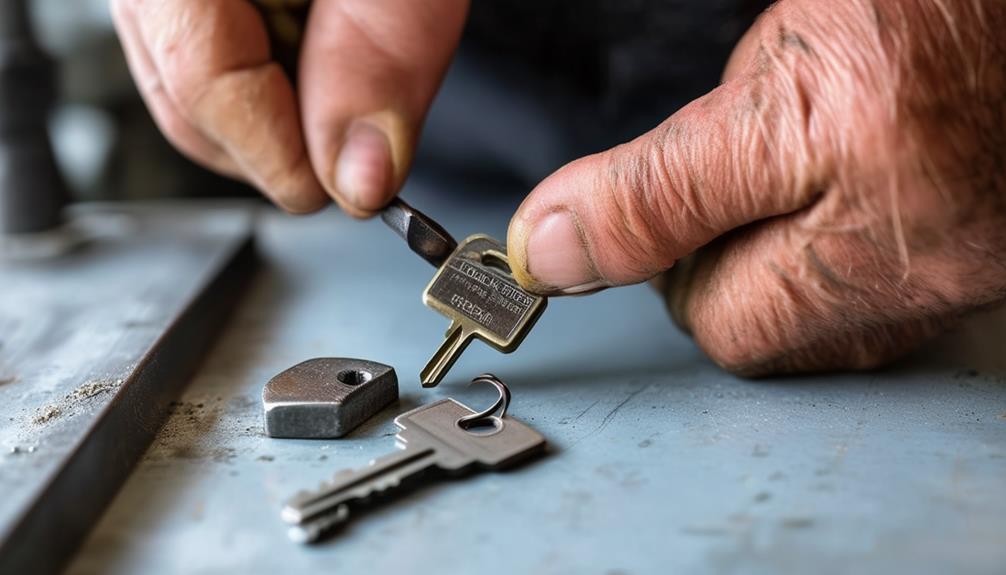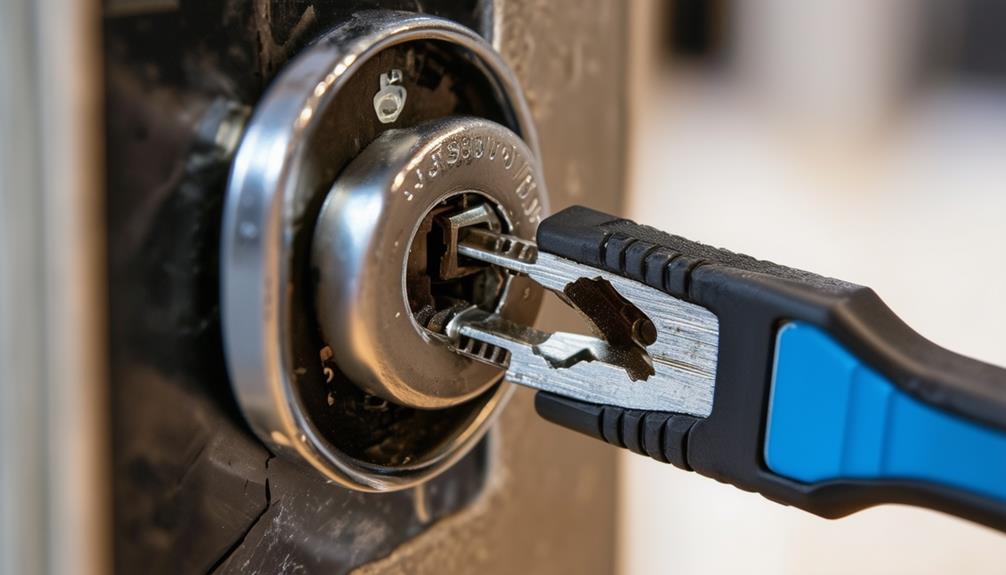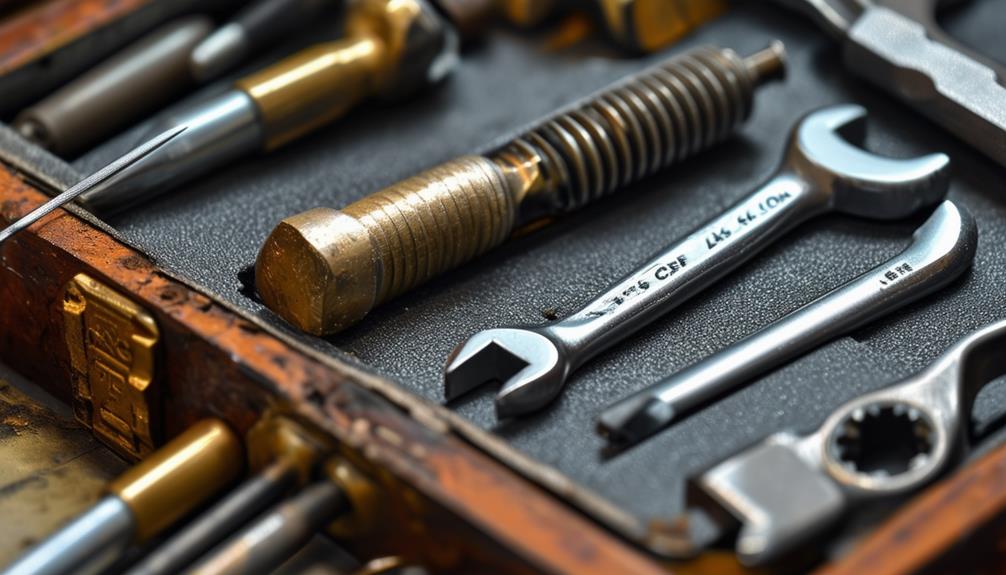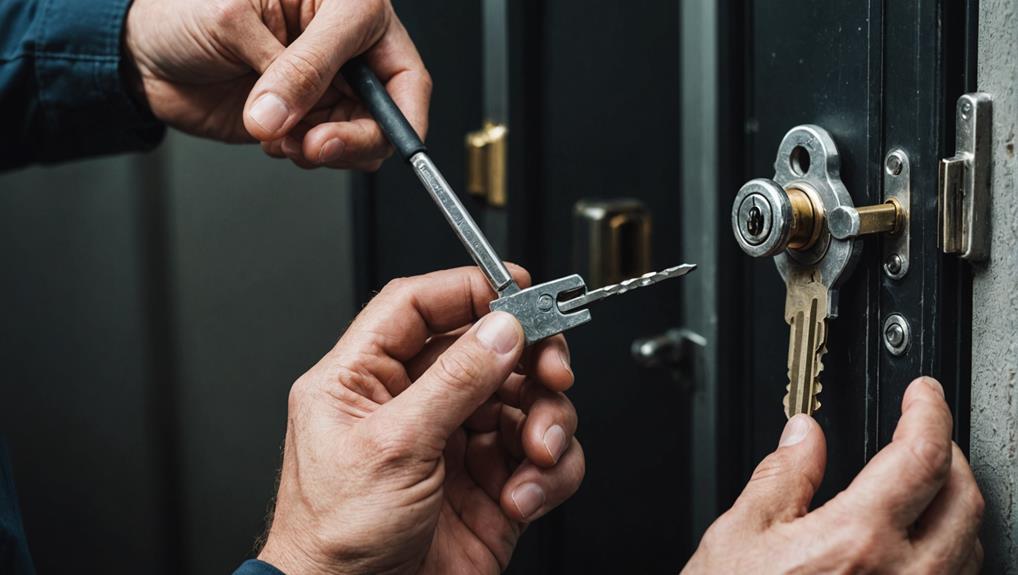To access high-security locks, you need advanced techniques and specialized tools due to their complex mechanisms and anti-pick technology. Utilize skills like single pin picking, raking, and bumping, but be aware that traditional methods may not work. Special tools like hook picks and tension wrenches are essential for success. Practice and precision are key; rushing will hinder progress. Additionally, understanding key control systems, impressioning techniques, and decoding locks are significant aspects to explore further for successful manipulation. Advanced methods like decoding techniques and tubular lock picking can enhance your locksmith abilities.
Key Takeaways
- Advanced techniques like single pin picking are crucial.
- Specialized tools like hook picks and tension wrenches are essential.
- Regular practice and precision are key for successful picking.
- Understanding lock mechanisms aids in effective manipulation.
- Impressioning and decoding techniques offer alternative entry methods.
Understanding Lock Mechanisms

Understanding lock mechanisms is essential for anyone interested in high-security locks, as these locks are engineered with advanced features to thwart unauthorized entry.
High-security lock mechanisms are designed with intricate components to provide enhanced protection against unauthorized entry. These locks often incorporate advanced features such as multiple pin tumblers, security pins, and sidebar mechanisms, which are part of their high resistance to attacks. Understanding how these components interact is vital in grasping the complexity of high-security locks.
High-security lock mechanisms operate based on precise alignment and manipulation of internal components. Pin tumblers must be lifted to the correct height simultaneously, while security pins add an additional layer of complexity by requiring specific manipulation techniques.
The sidebar mechanism, often found in advanced locks like dimple or slider locks, further increases security by requiring precise alignment for the lock to open.
Picking High-Security Locks

When picking high-security locks, you'll need to rely on advanced techniques and specialized tools to successfully bypass their intricate mechanisms.
These locks are designed to resist traditional picking methods, requiring a higher level of skill, practice, and precision to manipulate.
Their complex keyways and anti-pick technology add additional layers of difficulty, making it essential for locksmiths and enthusiasts to be well-versed in their functionality.
With dedication and the right tools, you can develop the expertise needed to conquer even the most challenging high-security locks.
Advanced Lock Picking
To successfully pick high-security locks, you must possess advanced skills and tools that go beyond traditional lock picking techniques.
Advanced lock picking involves a deep understanding of lock mechanisms, precise control, and the ability to manipulate complex systems. Unlike basic locks, high-security locks have additional features such as security pins, sidebars, and magnetic components that require specialized techniques to overcome.
Advanced lock picking techniques include methods like single pin picking, raking, and bumping, which demand a higher level of finesse and patience.
Single pin picking involves manipulating each pin individually to set them at the sheer line, requiring a delicate touch and keen tactile feedback. Raking involves quickly moving a specially designed pick across the pins to set them simultaneously, relying on speed and intuition. Bumping utilizes a key-like device called a bump key to exploit the lock's pin tumblers through rapid impact.
Mastering these advanced techniques takes practice, skill, and a deep understanding of lock mechanics.
It requires patience and persistence to hone your abilities and successfully pick high-security locks.
Specialized Tools Needed
For successfully picking high-security locks, acquiring the right tools is essential. When dealing with high-security locks, traditional lock picking tools may not be sufficient. Specialized tools designed specifically for high-security locks are vital for a successful outcome. These tools are engineered to navigate the intricate mechanisms and unique features of high-security locks, allowing for more precise manipulation.
One essential tool for high-security locks is the hook pick. This tool is designed to navigate the complex pin configurations commonly found in these locks. The hook pick is vital for setting pins individually to the correct position without disturbing the others.
Another indispensable tool is the tension wrench. This tool is used to apply torque to the lock's cylinder, allowing for the manipulation of the pins. The tension wrench must be carefully controlled to maintain the necessary pressure throughout the picking process.
Practice and Precision
To effectively pick high-security locks, practice and precision are paramount. High-security lock picking requires dedication to honing your skills through regular practice. The intricate mechanisms of these locks demand a steady hand and acute attention to detail.
Start by familiarizing yourself with the lock's components and understanding how they interact. Practice on various high-security locks to grasp different configurations and mechanisms.
Precision is key when attempting to pick high-security locks. Every movement must be deliberate and calculated. Apply just the right amount of pressure and listen for subtle feedback from the lock.
Develop a methodical approach to systematically test each pin until the lock finally yields. Remember, rushing through the process will only hinder your progress. Take your time and focus on each step with care.
Bypassing Key Control Systems

By understanding the vulnerabilities in key control systems, you can effectively bypass high-security locks. One common method is to exploit key control systems, which are designed to restrict unauthorized key duplication. By bypassing or manipulating these systems, intruders can gain access without the need for traditional lockpicking techniques. Below is a table outlining some key control system vulnerabilities and corresponding bypass methods:
| Key Control System Vulnerability | Bypass Method |
|---|---|
| Lack of Proper Authorization | Social Engineering |
| Weak Encryption of Key Data | Key Cloning Devices |
| Vulnerable Key Storage Locations | Physical Key Replication |
Understanding these vulnerabilities allows intruders to target weaknesses in key control systems, making it easier to circumvent high-security locks. By utilizing these bypass methods, individuals with malicious intent can gain unauthorized access to secure areas. It is essential for security professionals to be aware of these vulnerabilities to implement countermeasures effectively.
Impressioning Techniques

Understanding and exploiting vulnerabilities in high-security locks goes beyond just bypassing key control systems. Impressioning techniques are a valuable skill in the world of lock picking, as they demonstrate the necessity of ethical use of lock picking skills.
This method involves creating a working key for a lock by inserting a blank key, applying pressure, and then turning it to create marks on the key. By repeating this process and filing down the key based on the marks left by the lock, a working key can be fashioned without the need for disassembling the lock itself.
Impressioning techniques require patience, precision, and a good understanding of how locks operate. It's a subtle art that allows a locksmith to create a key that perfectly matches the internal mechanisms of the lock.
This method can be particularly useful when dealing with high-security locks that are resistant to other forms of picking.
Decoding Locks

To successfully decode high-security locks, you'll need to focus on three key points: identifying lock pins, precise placement of tension tools, and mastering pin manipulation techniques.
Understanding the common challenges in re-keying, such as misalignment of pins and insufficient key tension, can greatly enhance your ability to navigate the intricate mechanisms of these locks and increase your chances of accessing them.
Lock Pin Identification
Upon inserting your lock picking tool into the keyhole, you'll encounter a series of pins that must be manipulated into the correct position to release the mechanism. This process is known as lock pin identification. Each pin in the lock corresponds to a specific point on the key's bitting, and when all pins are aligned correctly, the shear line is cleared, allowing the lock to turn and open.
To identify the pins, you can use a variety of tools such as lock picks, feeler picks, or a decoder. By gently lifting each pin one at a time, you can feel for the binding pin that resists movement.
Once you identify the binding pin, carefully lift it to the correct height until you hear or feel a slight click, indicating it's set. Repeat this process for each pin until all are correctly positioned.
Mastering lock pin identification is essential for successfully decoding locks and gaining access to high-security mechanisms. With practice and patience, you can become adept at recognizing and manipulating the pins within a lock to free it efficiently.
Tension Tool Placement
Proper placement of the tension tool is essential when decoding locks. The tension tool is used to apply rotational force to the lock cylinder, allowing the pins to be manipulated.
To effectively use the tension tool, position it at the bottom of the keyway, applying just enough pressure to create slight tension. This tension is vital as it helps hold the pins in place once they reach the shear line.
When inserting the tension tool, make sure it doesn't obstruct the movement of the lock pick. Placing the tension tool too high in the keyway can impede the pick's ability to reach and manipulate the pins effectively.
Conversely, inserting it too low can cause the tool to slip or disengage from the lock cylinder.
Pin Manipulation Techniques
When decoding locks through pin manipulation techniques, it's essential to understand the intricate interplay between the lock pins and the shear line.
Pin manipulation techniques involve skillfully manipulating the pins inside the lock to align them correctly, allowing the plug to rotate and the lock to open smoothly.
Here are some key methods used in pin manipulation techniques:
- Single Pin Picking: Involves setting each pin individually to the shear line.
- Raking: Quickly moving a pick in and out to bounce pins to the shear line.
- Bump Keys: Specially designed keys used to bump pins into place.
- Progressive Pinning: Practicing on locks with increasing pin complexity to enhance skills.
Using Lock Bypass Tools

To effectively bypass high-security locks, you'll need to utilize specialized tools designed for this purpose. Lock bypass tools come in various forms, each serving a specific function in gaining unauthorized access.
For instance, understanding the vital tools that lock picking experts rely on can enhance your proficiency with these devices. One commonly used tool is the bypass knife, which allows you to manipulate the locking mechanism without needing the key. By sliding the bypass knife into the keyway and applying pressure, you can retract the locking bolt and open the lock without the original key.
Another vital tool is the bypass gun, which uses a different technique to manipulate the pins inside the lock, enabling quick entry without causing damage. These tools require practice and skill to master effectively, as using them incorrectly can lead to lock damage or failure to open the lock.
When using lock bypass tools, it's essential to exercise caution and verify you have the legal right to access the lock in question. Understanding the mechanisms behind these tools will help you become proficient in bypassing high-security locks when necessary.
Advanced Lock Picking Methods

If you're seeking to elevate your lock-picking skills beyond basic techniques, exploring advanced lock picking methods can provide you with a deeper understanding of high-security locks.
By mastering these techniques, you can greatly enhance your proficiency in manipulating complex locking mechanisms, making you a more versatile locksmith.
When delving into advanced lockpicking methods, consider the following:
- Decoding Techniques: Learn how to analyze lock mechanisms and decode their inner workings to better manipulate them.
- Impressioning: Utilize specialized tools and techniques to create a working key for a lock without disassembling it.
- Tubular Lock Picking: Master the art of picking tubular locks using specialized tools designed for this purpose.
- Bumping: Explore the technique of lock bumping, which involves using a specially crafted bump key to manipulate pins quickly.
For a more thorough understanding of these skills, refer to advanced lock picking techniques.
Frequently Asked Questions
Can High-Security Locks Be Picked Without Leaving Any Evidence of Tampering?
Yes, high-security locks can be picked without leaving any evidence of tampering.
Skilled professionals can manipulate these locks using specialized tools and techniques that leave minimal to no marks.
This requires a high level of expertise and precision to bypass the security measures without detection.
With the right tools and knowledge, it's possible to open high-security locks covertly.
Are There Legal Ramifications for Possessing Lock Bypass Tools?
Possessing lock bypass tools could result in legal consequences.
It's important to be aware that in many places, owning these tools without a valid reason can be considered a crime. Authorities take this matter seriously due to the potential for misuse in criminal activities.
Remember, staying informed about the laws regarding lock bypass tools can help you avoid getting into trouble with the law.
It's better to be safe than sorry.
How Do Lockpickers Protect Themselves From Accidental Lockouts?
To avoid accidental lockouts, lockpickers commonly carry spare keys or tools for bypassing locks.
It's crucial to practice techniques in a controlled environment to minimize the risk of getting locked out.
Stay mindful of your surroundings and always have a backup plan in case something goes wrong.
Being prepared and cautious will help prevent unwanted situations and guarantee you can safely navigate through your lockpicking endeavors.
Can Impressioning Techniques Work on Electronic High-Security Locks?
Impressioning techniques mightn't work on electronic high-security locks due to their complex digital mechanisms.
These locks rely on advanced encryption and unique algorithms, making traditional impressioning methods ineffective.
However, some locksmiths have developed specialized tools and techniques to bypass electronic security measures.
Understanding the specific vulnerabilities of each lock is essential for successful penetration, as even high-tech systems can have weaknesses that skilled professionals can exploit.
What Are the Risks of Attempting Advanced Lock Picking Methods on High-Security Locks?
Attempting advanced lock picking methods on high-security locks carries significant risks.
You may damage the lock mechanism, rendering it inoperable and potentially increasing security vulnerabilities.
Furthermore, unauthorized entry attempts could result in legal consequences if caught.
It's vital to weigh the potential consequences against the benefits before engaging in such activities.
Conclusion
You've now mastered the art of accessing high-security locks with precision and finesse. Remember, practice makes perfect, and with the right tools and techniques at your disposal, no lock will stand in your way. So go forth and conquer, fearless locksmith, for you have accessed the secrets of the lock world!









